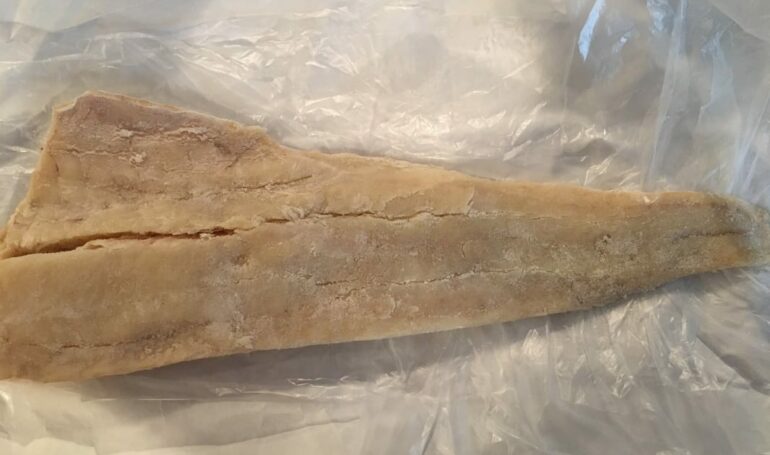
Salted Cod & Potatoes
If you’ve been following my recipes and this website for a bit, this recipe might surprise you. After all, isn’t this a lazy Italian cooking site? So how did a recipe that takes four days from start of preparation to table make it here anyway? Well, fear not, the work is minimal for the first four days, but even still, selling this dish as lazy is probably a stretch. That said, I have fond memories of eating salted cod with potatoes (or baccala e patati in my Calabrian dialect) growing up in Southern Italy. It’s a very nostalgic dish for me, one that was frequently eaten in my household around the holidays. It was one of my dad’s preferred dishes and whenever we had it, it was generally my dad’s idea and not my mom’s! He’d buy it at the local weekly market, much to my mom’s dismay. He’d come home from the market with bags full of fresh seasonal foods, cheeses, salami and the baccala. My mom would smell it before it was even out of the bag. “Don’t tell me you brought home baccala,” she would proclaim. And there it was sticking out of the bag, stinky and in all its glory. “E dai, e festa!” My dad would rebuttal: “Come on, it’s the holidays!”
Basically, baccala is codfish that has been preserved by drying and curing it with salt. When you buy a slab of it, it will be pretty stiff, clearly heavily salted and yes, a bit stinky. You’ll likely need to head to a specialty shop for it, as mainstream grocery stores will likely not carry it. Breaking another one of my lazy rules, the trip to the specialty store. “E dai, e festa!” Let’s make the extra effort!

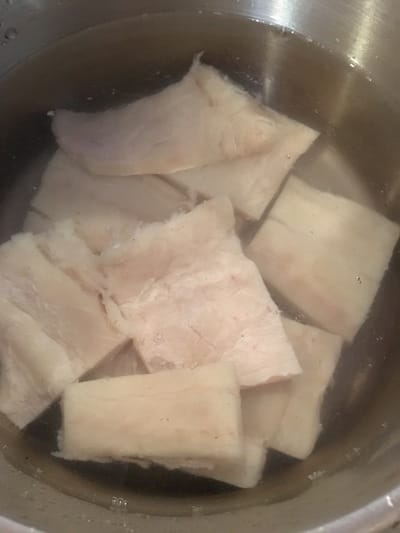
When you bring it home, try to remove any visible salt, cut it in chunks and add it to a stainless steel pot, submerge it in plenty of cold water, cover it and place it in the fridge. You’ll need to change the water at least twice, preferably three times a day, for about three to four days. Changing the water is very important and key in the process, as that is the only way of removing the salt. You don’t want it soaking in salty water. Remembering to do this is a different story. I may have had to get out of bed in the middle of the night, two nights in a row, to do this. Whose bright idea was this anyway? “E dai, e festa!”
Growing up, my parents would argue about this step all the time! The deal in our household was that this would be my dad’s responsibility, given that my mother did not care much for it. “Did you change the water to the baccala?” My mom would ask my dad. The general reply: “No, you do it!” And the general reply to that: “WHY, why do you always bring me work?? You change it!” And back and forth it went, arguing the way only Italian couples can. Loud enough to make one wonder if they are actually arguing or simply having an everyday conversation. In the end, my mom would always do it, not happily though! The final dish is actually very delicious. It’s the preparation, the changing of the water that’s a bit of a pain. That’s the part my mom hated, she’s actually very good at cooking it!
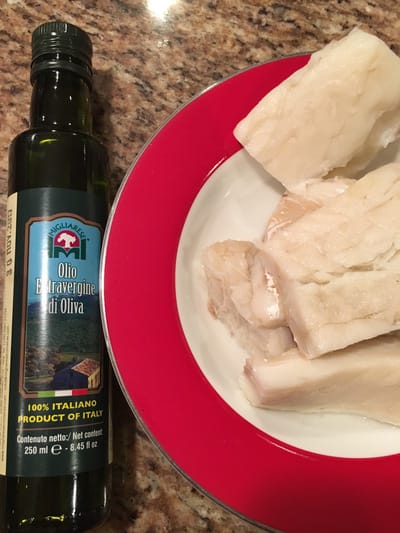
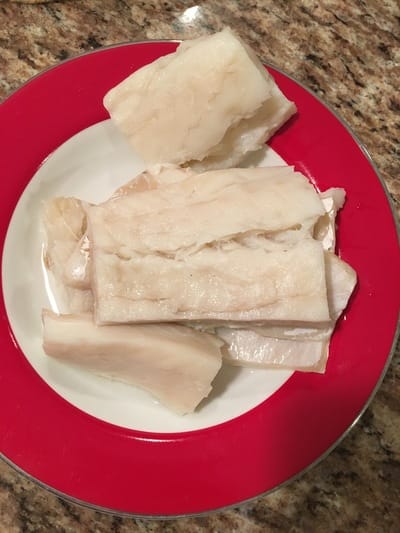
Let’s fast-forward 30 years. Since this dish is not my specialty and prepared rarely, I bring in the heavy artillery to help with the preparation, my mother! I unwrap the fish from the bag. “No you didn’t,” she says. “E dai, e festa!” She does not look amused. On the evening of the forth night, my mom and I prepared the baccala in the same way we cooked it in Italy. We reminisced about how much my father would have enjoyed it and decided that we were really cooking it for him. I could almost hear my dad say, “Yeah, but you get to eat it!”
Preparation after it has soaked for several days:
For the preparation, you’ll start by making a simple tomato base sauce using high quality olive oil. For this dish, you’ll need more oil than you usually do when making a tamato sauce. Simmer the oil, parsley and garlic for a minute, just to warm up the oil. Then add the tomatoes and cook for a few minutes. I left the garlic pieces rather large so we can pull them out before serving, otherwise, mince it.
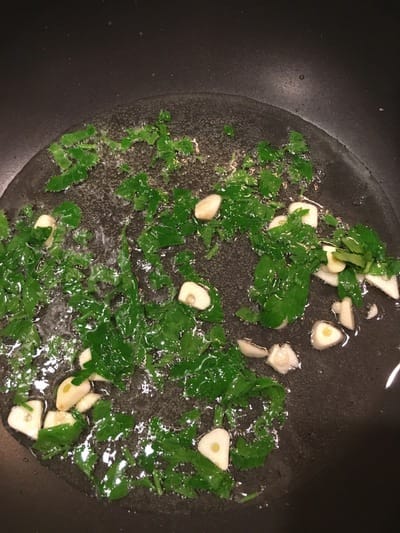
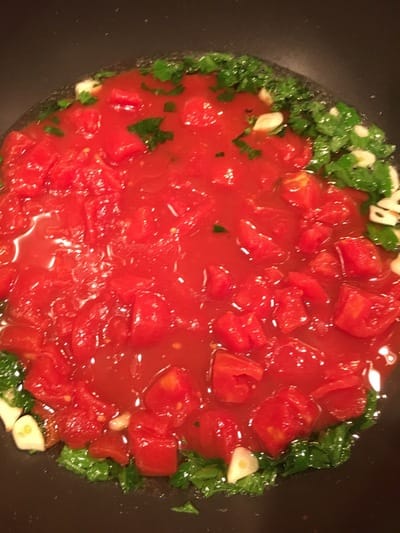
Next, your will add the potatoes with some water. Allow the potatoes to cook for an additional five minutes. After the potatoes have cooked for a short bit, add your chunks of baccala and continue cooking until cooked completely.

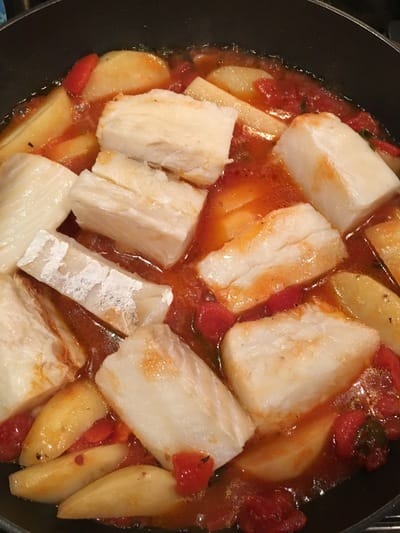
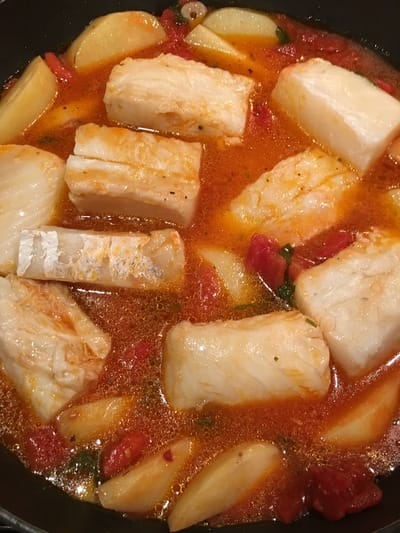
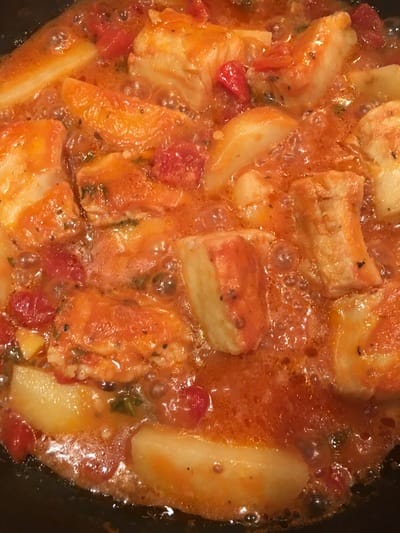
Ingredients:
1.5 to 2 pounds of salted cod that has been prepped for cooking (see soaking steps above)
1/3 cup of olive oil
2 – 3 garlic gloves, sliced
2 – 3 tablespoons chopped parsley
1 teaspoon oregano
1 14 oz can of diced tomatoes
3 large potatoes, diced
Water – as needed
Salt – as needed, may not be needed at all
Directions:
- Start by washing the baccala thoroughly one final time after it has been in the water for four days. Set it aside.
- In a large sauté pan, add the olive oil, garlic and parsley. (Since this was a special recipe that required a good amount of oil, we used Migliaresi, imported from our native Calabria. You can purchase ithere). Simmer for about one minute, just enough to warm up the oil.
- Add the tomatoes and cook for about 5 minutes.
- Add the potatoes and about one cup of water and cook for an additional five minutes.
- Add the baccala to the pan and about one more cup of water. Simmer on medium heat, uncovered. Depending on the thickness of the baccala, you will need to cook it anywhere from 15 – 20 minutes. You can start tasting it at 15 minutes to check for doneness and salt. If needed, add a very small amount of salt. Serve with some crusty bread for dunking in the delicious sauce.
*Tips: You can use the same exact method and substitute the baccala with fresh cod loins. This will reduce the amount of work substantially (nothing like waking up in the middle of the night and remembering to change the water!) and also will cook in less time. If you opt for fresh cod loins, cut the potatoes in smaller dices and add the fish and potatoes to the tomatoes at the same time. Also, as you can see from the images, we cut the potatoes a bit on the large side, so we realized they’d have to cook them longer than the fish. You can save yourself an extra step but cutting the potatoes smaller than we did and add the fish and potatoes at the same time to the sauce.


What to Pack for Italy
Cosa Mettere in Valigia per l'Italia
Everyone is always asking me what they should pack for Italy,
so I’ve created a quick reference guide that you can use for your next trip.
Hint: You don’t need nearly as much as you think you do!

Leave a Reply